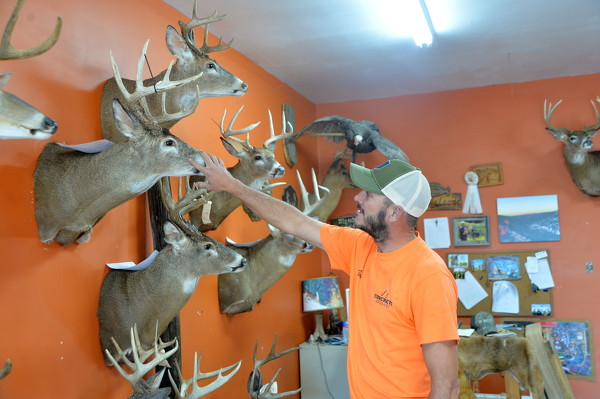Tuesday, October 11th, 2022
Tips for hunters looking for trophies this season
By Hank Nuwer

Photo by Paige Sutter/The Daily Standard
Joe Knapke of K & J Taxidermy in Maria Stein stresses that field dressing a white-tailed deer properly results in a trophy of a lifetime.
Many hunters would agree that nothing is more disappointing to hear than a taxidermist declare the hide of the once-in-a-lifetime trophy whitetail deer they've bagged is damaged.
Novice and even veteran hunters can make hide-destroying mistakes, says Joe Knapke of K & J Taxidermy in Maria Stein. The most common is to drag the deer to a vehicle in such a way that the animal's hair "gets rubbed the wrong way," said Knapke. He estimates that he sees about four damaged hides per season.
Is there a right way to cart off a deer? Knapke said lifting the head of the deer as high as possible is a good way to transport them.
Hides also can be ruined by a proliferation of bacteria. When removing the entrails, the hunter must take care not to sever the organs with the knife blade, Knapke cautioned.
A hunter also must try to keep the deer as cool as possible. When stopping to rest, hunters should stay in the shade, not in direct sunlight if possible.
Jerry Arling of Minster, a practitioner in taxidermy for more than a decade, stressed the importance of field dressing to keep the hide pristine.
"Many hunters drag the deer using a tarp," said Arling. "You don't want to get dirt and debris everywhere."
Once out of the woods, it is important hunters hang the deer in as cool a place as possible. A walk-in freezer is a hunter's best bet, Knapke said. He also suggested that hunters contact a butcher or taxidermist before going on a hunt to make sure there will be walk-in freezer access available if a clean kill is made.
"If nothing else is available, using a large chest freezer to keep the hide may work out," said Knapke.
Skinning, also known as caping, a whitetail deer requires a steady hand and precision.
"Cut along the white hair on its back," Arling said. "The incision runs into the back of the deer's armpit."
Knapke's main warning is "to never go in front of the legs to cut." The incision will show when the taxidermist tans the hide.
He also warned against cutting away too much of the hide, thereby resulting in a foreshortened hide no amount of taxidermy skill can fix.
If a hunter is unsure of his or her ability to remove the skin cleanly, Knapke said it is best to trust a seasoned taxidermist.
The season for white-tailed deer to be taken by bow runs through Feb. 5. Hunting deer by gun begins Nov. 28 through Dec. 8, along with Dec. 17-18, according to the Ohio Department of Natural Resource Division of Wildlife.


